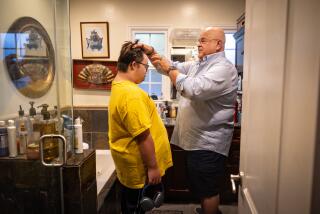THE STATE : EDUCATION : The Unkindest Cut of All: Head Start’s Uncertain Funds
- Share via
Californians have an enormous stake in the social-spending debates going on in Washington, but none of them hits closer to home than Head Start. Last year, California received, by far, the most Head Start money of any state, $371.2 million for programs enrolling 70,005 children. Where proposed budget cuts will fall most heavily is still being determined, but the result will undoubtedly be fewer children served by a program that even now reaches only 40% of 3- and 4-year-olds eligible because of their poverty.
The ethnic diversity that characterizes California is also reflected in Head Start centers located up and down the state. Children attend programs operated by, among others, the Yurok Indians in Klamath, the Stanislaus County Department of Education (for children of migrant workers), the Kai Ming Head Start program in San Francisco’s Chinatown, the Training and Research Foundation in Watts and other Los Angeles areas, the Fullerton School District and Campesinos Unidos in El Centro. Many of these centers would be adversely affected by budget cuts.
Head Start, created in 1965 as part of President Lyndon B. Johnson’s War on Poverty, has survived many budget battles, and it will hardly die at the hands of the current Congress. But unless it can distinguish itself among the voices beseeching budget-cutters, the program will not get the money it needs to make long-overdue improvements, some of which involve its basic mission of prepar- ing poor children to succeed in school.
Head Start had been the social program that both Republicans and Democrats could love and safely expand. It didn’t have to prove itself in a era when social programs are routinely challenged as wasteful of taxpayer money. It does now.
Head Start certainly has its problems. It can’t pay its teachers anything near what the public schools do, and it can’t always get enough qualified staff. Its classroom buildings often are fixer-uppers. And politicians frequently have played a numbers game, increasing the quantity of preschoolers served rather than improving quality of service.
At best, Head Start can hope to hold on to what it has. In negotiating its budget, the Senate sought to maintain Head Start spending at $3.5 billion, while the House proposed subtracting the $210- million increase the program received this year. The House appropriations committee reduced the proposed cut to $137 million.
Congress increased Head Start’s appropriation for the current year so more local programs could serve children under the age of 3. It also wanted all programs to concentrate on helping children make the transition to elementary school, improving program quality and paying teachers more. A Head Start teacher, on average, makes $16,700 annually, up from $10,000 five years ago. Nonetheless, some teachers are poor enough that their children qualify to attend the program.
Head Start had been targeted this spring for reductions, but Rep. Frank Riggs (R-Eureka) successfully contended that the program could not withstand “severe and sudden cuts.” Instead, money for Chapter One schools in poor neighborhoods, which may serve older brothers and sisters of Head Start children, was cut. Riggs believes that Head Start deserves support because of its “early intervention and prevention . . . the very best philosophical justification for spending the taxpayer’s hard-earned dollar.” But Riggs, an appropriations committee member, warns that Head Start will remain a convenient target for budget-cutters because it is “too fragmented” and so must streamline its administration. He also thinks Head Start must do better research to demonstrate its effectiveness.
Head Start is working on improving its success measures, which will help its advocates make their case in Congress. But how do you test the performance of its young children? How do you measure gains in their social skills? How can you quantify health problems prevented because of Head Start’s medical and dental screenings? How can you measure the profound changes that occur when parents, encouraged by Head Start, get more involved not only in their children’s educations but in the world around them? Head Start must find some answers.
One of the fathers of Head Start, Yale Univeristy psychology professor Edward F. Zigler, says the Clinton Administration is moving in the right direction to tighten quality control. But he urges beefed-up inspections and other administrative improvements, as well as necessary increases for employee’s salaries and better buildings.
The poor, by definition, don’t have the money to charter buses to bring thousands of the littlest lobbyists to Washington, but somebody should. For most people, looking a child in the eye and saying, “No, I don’t think we can afford to help you develop the skills and the good health you’ll need to succeed in school,” would be difficult. But absent any outcry, Congress may do just that.*






